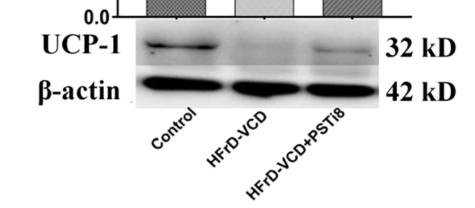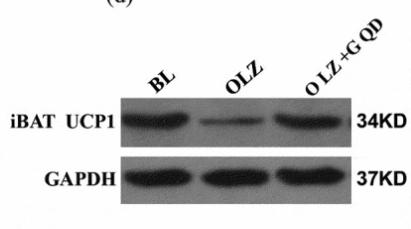UCP1 Antibody - #DF7720
| Product: | UCP1 Antibody |
| Catalog: | DF7720 |
| Description: | Rabbit polyclonal antibody to UCP1 |
| Application: | WB IHC |
| Reactivity: | Human, Mouse, Rat |
| Prediction: | Bovine, Horse, Sheep, Rabbit, Dog |
| Mol.Wt.: | 34 kDa; 33kD(Calculated). |
| Uniprot: | P25874 |
| RRID: | AB_2841189 |
Related Downloads
Protocols
Product Info
*The optimal dilutions should be determined by the end user.
*Tips:
WB: For western blot detection of denatured protein samples. IHC: For immunohistochemical detection of paraffin sections (IHC-p) or frozen sections (IHC-f) of tissue samples. IF/ICC: For immunofluorescence detection of cell samples. ELISA(peptide): For ELISA detection of antigenic peptide.
Cite Format: Affinity Biosciences Cat# DF7720, RRID:AB_2841189.
Fold/Unfold
mitochondrial brown fat uncoupling protein; Mitochondrial brown fat uncoupling protein 1; SLC25A7; Solute carrier family 25 member 7; Thermogenin; UCP 1; UCP; UCP1; UCP1_HUMAN; uncoupling protein 1 (mitochondrial, proton carrier); Uncoupling protein 1;
Immunogens
- P25874 UCP1_HUMAN:
- Protein BLAST With
- NCBI/
- ExPASy/
- Uniprot
MGGLTASDVHPTLGVQLFSAGIAACLADVITFPLDTAKVRLQVQGECPTSSVIRYKGVLGTITAVVKTEGRMKLYSGLPAGLQRQISSASLRIGLYDTVQEFLTAGKETAPSLGSKILAGLTTGGVAVFIGQPTEVVKVRLQAQSHLHGIKPRYTGTYNAYRIIATTEGLTGLWKGTTPNLMRSVIINCTELVTYDLMKEAFVKNNILADDVPCHLVSALIAGFCATAMSSPVDVVKTRFINSPPGQYKSVPNCAMKVFTNEGPTAFFKGLVPSFLRLGSWNVIMFVCFEQLKRELSKSRQTMDCAT
Predictions
Score>80(red) has high confidence and is suggested to be used for WB detection. *The prediction model is mainly based on the alignment of immunogen sequences, the results are for reference only, not as the basis of quality assurance.
High(score>80) Medium(80>score>50) Low(score<50) No confidence
PTMs - P25874 As Substrate
| Site | PTM Type | Enzyme | Source |
|---|---|---|---|
| S51 | Phosphorylation | Uniprot | |
| Y55 | Phosphorylation | Uniprot | |
| T61 | Phosphorylation | Uniprot | |
| S250 | Phosphorylation | Uniprot | |
| T260 | Phosphorylation | Uniprot | |
| T265 | Phosphorylation | Uniprot |
Research Backgrounds
Mitochondrial protein responsible for thermogenic respiration, a specialized capacity of brown adipose tissue and beige fat that participates to non-shivering adaptive thermogenesis to temperature and diet variations and more generally to the regulation of energy balance (By similarity). Functions as a long-chain fatty acid/LCFA and proton symporter, simultaneously transporting one LCFA and one proton through the inner mitochondrial membrane. However, LCFAs remaining associated with the transporter via their hydrophobic tails, it results in an apparent transport of protons activated by LCFAs. Thereby, dissipates the mitochondrial proton gradient and converts the energy of substrate oxydation into heat instead of ATP. Regulates the production of reactive oxygen species/ROS by mitochondria (By similarity).
May undergo sulfenylation upon cold exposure. May increase the sensitivity of UCP1 thermogenic function to the activation by noradrenaline probably through structural effects.
May undergo ubiquitin-mediated proteasomal degradation.
Mitochondrion inner membrane>Multi-pass membrane protein.
Brown adipose tissue.
Most probably functions as a monomer. Binds one purine nucleotide per monomer (By similarity). However, has also been suggested to function as a homodimer or a homotetramer. Tightly associates with cardiolipin in the mitochondrion inner membrane; may stabilize and regulate its activity.
Belongs to the mitochondrial carrier (TC 2.A.29) family.
Research Fields
· Environmental Information Processing > Signal transduction > Apelin signaling pathway. (View pathway)
· Human Diseases > Neurodegenerative diseases > Huntington's disease.
· Organismal Systems > Endocrine system > PPAR signaling pathway.
References
Application: WB Species: Rat Sample:
Application: WB Species: Rat Sample:
Application: WB Species: Mice Sample: adipose tissue
Restrictive clause
Affinity Biosciences tests all products strictly. Citations are provided as a resource for additional applications that have not been validated by Affinity Biosciences. Please choose the appropriate format for each application and consult Materials and Methods sections for additional details about the use of any product in these publications.
For Research Use Only.
Not for use in diagnostic or therapeutic procedures. Not for resale. Not for distribution without written consent. Affinity Biosciences will not be held responsible for patent infringement or other violations that may occur with the use of our products. Affinity Biosciences, Affinity Biosciences Logo and all other trademarks are the property of Affinity Biosciences LTD.



